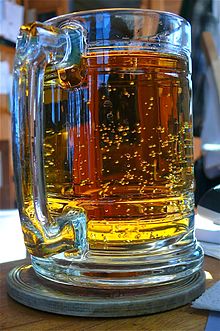Ginger ale

A glass of Vernors ginger ale
|
|
| Type | Soft drink |
|---|---|
| Country of origin | United States, Canada |
| Introduced | 1851 |
| Colour | Golden |
| Flavour | Ginger |
| Variants | Golden ginger ale and dry ginger ale |
Ginger ale is a carbonated soft drink flavoured with ginger in one of two ways. The golden style is credited to the American doctor Thomas Cantrell. The dry style (also called the pale style) is a paler drink with a much milder ginger flavour, and was created by Canadian John McLaughlin.
Thomas Cantrell, an American apothecary and surgeon, claimed to have invented ginger ale in Belfast, Northern Ireland, and marketed it with local beverage manufacturer Grattan and Company. Grattan embossed the slogan "The Original Makers of Ginger Ale" on its bottles. This was the older style Golden ginger ale, dark coloured, generally sweet to taste, with a strong ginger spice flavour. Ginger ale is clear; ginger beer is often cloudy due to the residues of brewing, and has a stronger ginger taste.
Dry ginger ale is recognized as a Canadian creation by John McLaughlin, a chemist and pharmacist. Having established a soda water bottling plant in 1890, McLaughlin began developing flavour extracts to add to the water in 1904. That year, he introduced "Pale Dry Ginger Ale", the bubbly libation that would be patented in 1907 as "Canada Dry Ginger Ale". An instant success, Canada Dry products were accepted by appointment to the Vice-Regal Household of the Governor General of Canada. The dry-style also became popular in the United States during the Prohibition era, when it was used as a mixer for alcoholic beverages. Dry ginger ale quickly surpassed golden ginger ale in popularity. Today, golden ginger ale is an uncommon, more regional drink exemplified by Vernors. By contrast, dry ginger ale is produced on a large scale internationally, and is a staple in supermarkets and bars, and on airlines.
Ginger ale commonly contains carbonated water, sugar or HFCS, and artificial or natural ginger-flavour. Ginger content is often listed on labels in a general "natural aroma" or "Natural flavoring" statement, to preserve secrecy of the complex proprietary mix of spices, fruits and other flavours used. Lemon, lime, and cane sugar are the most common of ingredients. Pineapple and honey are also occasional ingredients. Ginger ale can also contain yeast, when carbonated with natural fermentation.
...
Wikipedia
